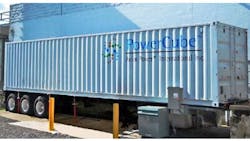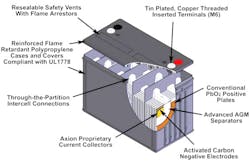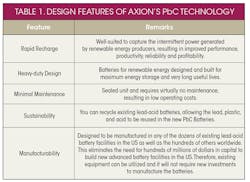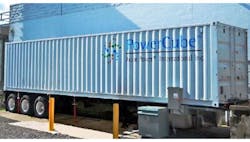Renewable energy power systems can take advantage of Axion's proprietary PbC® battery technology for short-term power storage. In a solar installation, the solar panels charge the batteries whose output powers a dc-to-ac inverter that provides a tightly-controlled frequency and amplitude output to the utility grid. Compared with conventional lead-acid batteries, PbC batteries used with a solar or wind power system offer:
· Faster recharge rates
· Greater charge acceptance
· Longer cycle lives in deep discharge applications
· Minimal maintenance
Related Articles
- Liquid Metal Battery Stores Power After Sun Or Wind Retreat
- Organic Mega Flow Battery Promises Breakthrough For Renewable Energy
- University Researchers Pursue Better, Safer Li-Ion Batteries
- Inverter/Charger Supports Grid-Interactive and Off-Grid Applications
- North Carolina State Improves Lithium-Ion Batteries and Stacked Solar Cells
- Carbon Nanotubes: Flexible Battery, Computer, What Next?
Shown in Fig. 1, the Axion battery is a multi-celled asymmetrically supercapacitive lead-acid-carbon hybrid battery. Like the conventional lead-acid battery, the Axion battery consists of a series of cells. Within its individual cells, however, construction is more complex. Negative electrodes in conventional lead-acid batteries have simple sponge lead plates. In contrast, the Axion’s negative electrodes are five-layer structures consisting of a carbon electrode, corrosion barrier, current collector, second corrosion barrier and second carbon electrode. These electrode structures are sandwiched together with conventional separators and positive electrodes and its cells are connected in series. The battery is filled with an acid electrolyte and is completely sealed.
Since 2004, laboratory prototypes of Axion's PbC batteries have undergone extensive testing. The test protocol involved a complete charge-discharge cycle every seven hours to a 100% depth of discharge. During testing, laboratory prototypes withstood more than 2,500 cycles before failure. In comparison, most conventional lead-acid batteries intended for deep discharge applications are only able to survive 400 to 600 cycles under similar operating conditions.
More than eight years were devoted to R&D on various aspects of this technology. Work focused on optimizing the design, including:
· Characterizing baseline performance
· Developing proprietary treatment processes for the activated carbon used in the electrodes
· Developing proprietary designs and manufacturing techniques for electrode assemblies
· Fabricating a series of material and design evaluation prototypes ranging from single cell to multi-cell batteries.
Conventional lead-acid batteries consist of two electrodes: a positive electrode made of lead dioxide (PbO2) and a negative electrode made of sponge lead (Pb). Both the lead dioxide and sponge lead materials are pasted onto lead grids with conventional separators placed between cells that are connected in series.
The PbC battery is a hybrid device that uses the standard lead acid battery positive electrode and a supercapacitor negative electrode made of activated carbon. The specific type of activated carbon has an extremely high surface area (1500 m2/g) and has been specifically formulated for use in electrochemical applications. During charge and discharge, the positive electrode undergoes the same chemical reaction that occurs in a conventional lead acid battery, i.e., lead dioxide reacts with acid and sulphate ions to form lead sulphate and water. The main difference in the PbC battery is the replacement of the lead negative electrode with an activated carbon electrode that does not undergo a chemical reaction at all. Instead, the very high surface area activated carbon electrode stores the protons (H+) from the acid in a layer on the surface of the electrode.
With conventional lead-acid batteries the concentration of acid changes from being very concentrated in the charged state to somewhat dilute in the discharged state as the acid is converted to water. In contrast, the PbC battery stores H+ in the negative electrode in the fully charged state, which moves to the positive electrode during discharge where they are neutralized to form water. The result is reduced acid concentration swings from the charged to discharged state, reducing grid corrosion on the positive electrode, leading to longer positive electrode life.
The rapid recharge and deep discharge capacity of the PbC battery are well-suited for intermittent power sources like wind and solar. When coupled with the ability to deliver longer cycle lives with minimal maintenance, grid connected systems based on our PbC technology will offer a greater total number of useful cycle lives. If battery cost per charge/discharge cycle is low enough, peak shaving and grid buffering for traditional utilities may also be cost effective. Table 1 lists the PbC battery’s design featuresAxion has also developed the PowerCube™, a mobile energy storage system using multiple PbC batteries that can be configured to deliver up to 1 MW for 30 minutes or 100 kW for 10 hours (Fig. 2).
Solar Installation
For more than 2 ½ years, Axion's 500 kW PowerCubes have been connected into the PJM grid utility network, one of the nation's largest power transmission organization serving more than 58 million people in all or parts of 13 states,. Set up as a demand response and frequency regulation asset, Axion developed and tweaked a working model in a real world setting utilizing the PowerCube's ability to participate 24/7 in the PJM frequency regulation application.
Following the initial installation, Axion received a follow-on order for four more PowerCube energy storage systems. The Cubes will provide storage for energy created by a commercial solar panel system and provide power storage and frequency regulation on the PJM grid. In addition, ancillary circuits provide seamless switching between the output of the solar-inverter and the utility’s generators. The new order includes batteries, racks, wiring, a data communication system and the electronics coordination needed to outfit and install the PowerCubes. Each of the PowerCubes will be tied to solar arrays that produce between 500 kW and 700 kW and the PowerCubes will each provide 500 kW (both 500 kW up and 500 kW down) for frequency regulation.
About the Author

Sam Davis
Sam Davis was the editor-in-chief of Power Electronics Technology magazine and website that is now part of Electronic Design. He has 18 years experience in electronic engineering design and management, six years in public relations and 25 years as a trade press editor. He holds a BSEE from Case-Western Reserve University, and did graduate work at the same school and UCLA. Sam was the editor for PCIM, the predecessor to Power Electronics Technology, from 1984 to 2004. His engineering experience includes circuit and system design for Litton Systems, Bunker-Ramo, Rocketdyne, and Clevite Corporation.. Design tasks included analog circuits, display systems, power supplies, underwater ordnance systems, and test systems. He also served as a program manager for a Litton Systems Navy program.
Sam is the author of Computer Data Displays, a book published by Prentice-Hall in the U.S. and Japan in 1969. He is also a recipient of the Jesse Neal Award for trade press editorial excellence, and has one patent for naval ship construction that simplifies electronic system integration.
You can also check out his Power Electronics blog.



